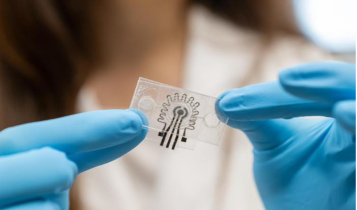Sweat, when monitored, reveals valuable information about human health. Wearable sensors developed to monitor glucose levels have thus far been insufficient—until now. Penn State researchers created a novel wearable patch that may be up to the task.
Made of a laser-modified graphene nanocomposite material, the device detects specific glucose levels in sweat for three weeks while monitoring body temperature and pH levels. The results of the research were published in Advanced Functional Materials.
In the past, low biomarker concentration levels in sweat and variability of other factors such as pH, salinity, and temperature took sweat biosensors past the limits of their detection and accuracy. The current device accounts for the variability while measuring glucose with required specificity for weeks at a time. Despite limitations based on low sensitivity to glucose and a limited surface area for the necessary electrochemistry, LIG electrodes are simple to fabricate, affordable, and flexible.
Working at nanoscale, researchers used a simple laser treatment to create a stable, 3D network of highly conductive noble metal alloys, gold and silver in this case, and carbon-based nanocomposite materials on the porous LIG electrode.
By heating the alloy nanocomposite material with a simple laser treatment, the material also resists agglomeration, where nanoparticles coalesce into clusters, limiting the material’s surface area.
Glucose on the surface of the modified LIG electrode oxidizes at lower potential, generating a measurable current or potential change directly proportional to the overall glucose concentration in the solution. The laser-treated sensor loses only 9% of its sensitivity over three weeks compared to 20% sensitivity loss for a sensor without laser treatment.
In addition to glucose, the LIG electrode also responded to changes in pH levels. The researchers combined the dual glucose and pH sensor with another LIG-based temperature sensor and a stretchable layer with coil-shaped microfluidic channels to continuously collect and route sweat for sampling.
The device allows for the calibration of glucose measurements based on fluctuations in sweat pH and body temperature from activities, including exercise and eating. Twice the width of a postage stamp and affixed to the skin with adhesive tape, the device wirelessly communicates the collected data to a computer or mobile device for real-time monitoring and analysis. The result is a sensor with notable sensitivity and stability. The low-cost platform offers convenient, accurate, and continual analysis of sweat in diverse conditions.


